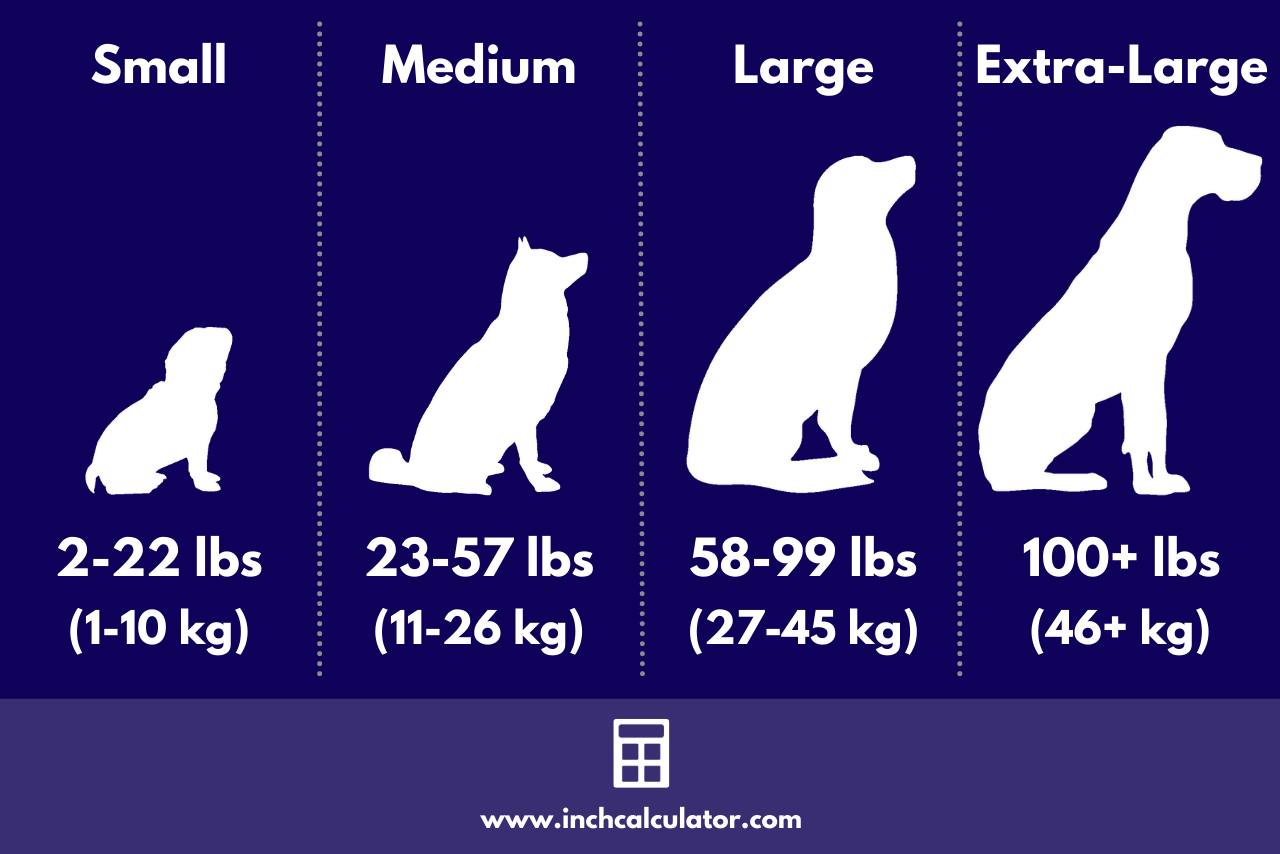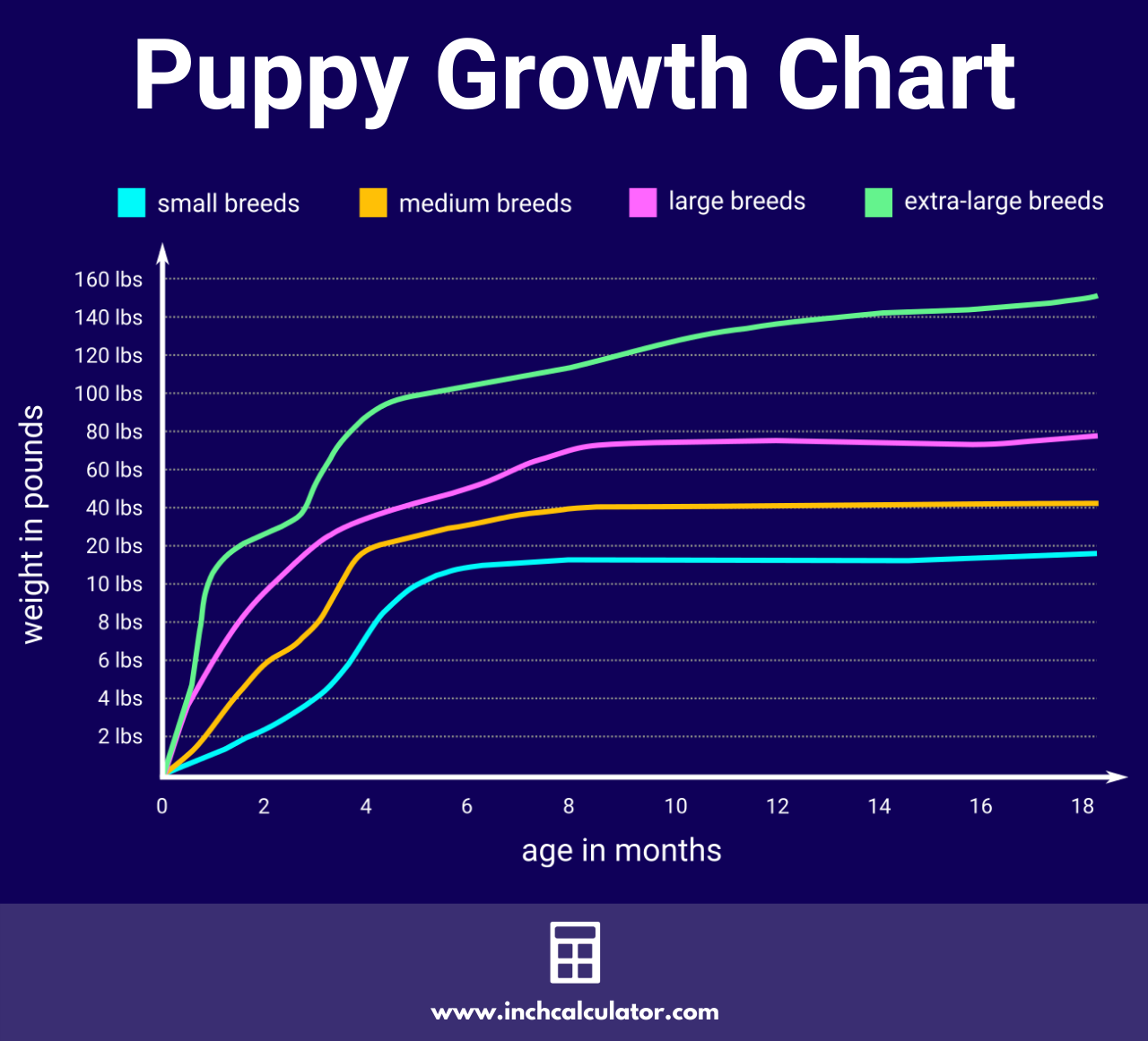Dog Weight Calculator – How Big Will Your Puppy Get?
Enter your puppy’s current age and weight to estimate how big they will get as an adult.
Dog's Adult Weight:
On this page:
- Dog Weight Calculator
- How to Estimate How Big Your Puppy Will Get
- Method One: Puppy Growth Formula
- Method Two: Refer to the Average Adult Weights for Breed
- Method Three: Check the Parents’ Weight
- Puppy Size Chart
- How Fast Do Puppies Gain Weight?
- Puppy Growth Chart
- When do Dogs Stop Growing?
- References
How to Estimate How Big Your Puppy Will Get
If you have a puppy, you might be wondering how big they will get as they grow. Several factors influence this, including breed, sex, genetics, diet, and their amount of exercise.[1]
There are several methods to estimate how big a puppy will get as an adult. The first and simplest way is to use a basic formula, which is how the calculator above estimates a puppy’s growth.
Method One: Puppy Growth Formula
You can use the following formula to estimate how big your dog will get:
Adult Size = Current Weight / Age in Weeks × 52
This formula is most accurate for breeds that mature in 12 months (52 weeks), but some breeds mature much more quickly or slowly. Larger breeds tend to reach their adult weight in 18 months, while small breeds reach their adult weight in as little as 6-8 months.
Another variation of this formula is to double their weight at 6 months of age to get an approximate adult weight.
Method Two: Refer to the Average Adult Weights for Breed
Given that breed is the largest factor impacting how big a dog will get, referencing the information about their breed is a great way to get a ballpark of what size your puppy might be when they grow up.
The American Kennel Club published a comprehensive list of the adult size ranges for hundreds of dog breeds, which serves as a great reference for this.[2] The chart below highlights the adult sizes for some common breeds.
Small Breeds
- Pugs: 14-18 lbs
- Chihuahuas: <6 lbs
- Dachshunds: 16-32 lbs
Medium Breeds
- Basset Hounds: 40-65 lbs
- Collies: 30-55 lbs
- Huskies: 35-60 lbs
Large Breeds
- Labrador Retrievers: 55-80 lbs
- German Shepherds: 50-90 lbs
- Alaskan Malamutes: 75-85 lbs
Extra-Large Breeds
- Bullmastiffs: 100-130 lbs
- Great Danes: 110-175 lbs
- St. Bernards: 120-180 lbs
Method Three: Check the Parents’ Weight
Another method to estimate a dog’s adult weight is to look at the weights of its parents. While other factors do play a role, this is a reasonable way to estimate their size when the puppy is fairly young.
For example, you can average the weights of both parents to get a good idea of the pup’s adult weight. It’s important to note that female dogs will tend to be closer to the size of the mother and males to the father.
This method is not likely to be precise if the parents are vastly different sizes.
You might also be interested in tracking how old your dog is in human years as they grow.
Puppy Size Chart
As we mentioned above, the fully-grown size of a dog will vary by its breed. Breeds are commonly subdivided into four different size ranges: small, medium, large, and extra-large.
| Size | Weight Range |
|---|---|
| Small | 2-22 lbs (1-10 kg) |
| Medium | 23-57 lbs (11-26 kg) |
| Large | 58-99 lbs (27-45 kg) |
| Extra-Large | 100+ lbs (46+ kg) |

These size ranges are sometimes subdivided. For instance, the small category is sometimes divided into toy, teacup, miniature, and standard small sizes.
| Size | Weight Range |
|---|---|
| Teacup | 4 lbs or less (<2 kg) |
| Miniature | 3-12 lbs (1.5-5.5 kg) |
| Toy | 5-12 lbs (2-5.5 kg) |
How Fast Do Puppies Gain Weight?
The rate that a puppy will grow depends on several factors, just like their adult weight does. Generally though, the breed and size category are good indicators of how fast they will gain weight.
Smaller breeds tend to grow very quickly and reach their adult weight by the time they’re 6-8 months old in some cases. Larger breeds may not be fully grown until they are 12 to 18 months old, while extra-large breeds might not reach their adult weight until they are 24 months old.[3]
Like humans, puppies generally do not grow at a consistently steady pace, but rather experience growth spurts and periods of faster growth, followed by periods of slow or no growth.
Curious how much you should feed your puppy? Try our calorie calculator to estimate how much food they need.
Puppy Growth Chart
The chart below shows the difference in growth progression for different breed sizes and when you might expect to see the most growth in your puppy.

Knowing how much your dog weighs is important, especially when determining how much water they should drink or how dangerous chocolate is for them.
If you do not have a scale at home that you can use to weigh your dog, most vets will allow you to drop by for a quick weight check.
When do Dogs Stop Growing?
As we mentioned above, the size of the dog impacts when they might reach their adult weight. Smaller breeds generally stop growing completely at 10-12 months, while larger dogs stop growing at 18-24 months.[4] Larger dogs take longer to stop growing due to the length of time it takes to develop their larger skeletal frame.
If you have children, we also have a height prediction calculator that you might find interesting.
References
- Hawthorne, A., Booles, D., Nugent, P., Gettinby, G., & Wildinson, J., Body-Weight Changes during Growth in Puppies of Different Breeds, 134(8), 2027S-2030S. https://pubmed.ncbi.nlm.nih.gov/15284394/
- American Kennel Club, Breed Weight Chart, https://www.akc.org/expert-advice/nutrition/breed-weight-chart/
- Paretts, S., Puppy Growth Chart: When Does My Puppy Finish Growing?, American Kennel Club, https://www.akc.org/expert-advice/health/when-does-my-puppy-finish-growing/
- Fivecoat-Campbell, K., At What Age Do Dogs Stop Growing?, PetMD, https://www.petmd.com/dog/care/what-age-do-dogs-stop-growing


